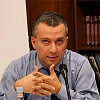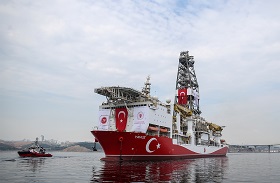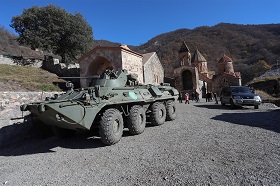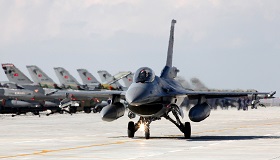Russo–Turkish relations have been at the forefront of recent media discussions. Cooperative competition, “frenemies,” managed rivalry, “co-opetition,” and other catchy terms are used to describe bilateral relations between Moscow and Ankara. However, the reality is that the two countries have both overlapping, and yet contradictory, interests in many parts of the world. Of these, the most critical for Russia is the post-Soviet space, and the Caucasus in particular.
In many, if not most areas, interests between the two countries continued to contradict and conflict, most notably with regard to the fate of Idlib and northeastern Syria and the situation in Libya. This complex maze of coinciding and contradicting interests was governed by unspoken ground rules between the two sides, in order to avoid another entanglement on the scale of the Sukhoi shootdown. One of those rules was Ankara’s unconditional acceptance of Moscow’s dominant position in the post-Soviet space.
However, Erdogan’s frustrations with Moscow in the Syrian and Libyan theatres led him to do the unthinkable—violate this rule in the fraught conflict over Nagorno-Karabakh between Azerbaijan and the Armenia-allied Karabakh Armenians. His flagrant intervention in the post-Soviet space amid the COVID pandemic paid significant political dividends. Erdogan’s “quick war” in the Caucasus strengthened his position at home, while critically weakening Russia’s main strategic ally in the region (Armenia) and thus Moscow’s regional standing generally. Overall, a combination of NATO military tactics, Turkish Bayraktars, and Armenian incompetence proved to be fatally decisive factors in Karabakh.
Although Moscow’s position in the region remains firm, Kremlin elites are becoming increasingly wary of Ankara’s efforts to project its influence along Russian borders. Russian Presidential Spokesman Dmitry Peskov was jokingly dismissive of Erdogan’s display of a map of a vast pan-Turkic world with a nationalist political ally. However, beneath the cool self-confidence, many in the Kremlin are becoming increasingly frustrated with Ankara’s comportment. Indeed, the threats are significant. Between Ankara’s actions and a growing NATO build-up in Ukraine, Moscow faces one of the greatest security challenges it has confronted since 1991. How Russian President Vladimir Putin and his administration will deal with it remains to be seen. One thing is very clear: the Kremlin’s patience is not infinite.
Russo–Turkish relations have been at the forefront of recent media discussions. Cooperative competition, “frenemies,” managed rivalry, “co-opetition,” and other catchy terms are used to describe bilateral relations between Moscow and Ankara. However, the reality is that the two countries have both overlapping, and yet contradictory, interests in many parts of the world. Of these, the most critical for Russia is the post-Soviet space, and the Caucasus in particular.
Managing Competition in Moscow’s Backyard
Since the dissolution of the Soviet Union in 1991, the Russian Federation has viewed the entire post-Soviet space as a zone of its critical national security interest. Therefore, Moscow seeks to restrict the influence of other regional and global actors—in particular, that of the United States and the NATO military alliance. The Kremlin has consistently viewed the eastward expansion of NATO with considerable alarm, perceiving it as a violation of the trust in U.S.-Russian relations built during the Gorbachev-Reagan “détente” of the late 1980s. In keeping with that history, Moscow is very suspicious of the activities of any NATO member state in its immediate neighborhood. Turkey is no exception in this regard.
Ankara made its first foray into the Caucasus after 1991, with particular focus on developing relations with Azerbaijan. The ethnic and linguistic bonds with Baku served as an ideal basis for this policy. With the active support of war hawks in Washington, a network of gas and oil pipelines was built to bring Azerbaijani energy resources to the West through both Turkey and Georgia, an aspiring member of NATO. The aim, essentially, was to undermine Russia’s natural position as the dominant energy provider for Europe, and by extension, to weaken Russia’s position in other post-Soviet states, primarily in Ukraine and in Belarus. From the view of Washington war hawks keen on “containing Russia,” this East-West energy corridor would ideally extend further east. That is, it would extend across the Caspian, into the energy-rich post-Soviet Central Asia, especially Turkmenistan, home to the fifth largest reserve of natural gas in the world. The ultimate aim would be for NATO to surround Russia on its borders.
This vision directly clashes with the view commonly held in Moscow, which perceives the Caucasus as a vital part of its Eurasian underbelly. Of particular concern to the Kremlin is its volatile North Caucasus region. Therefore, it seeks to develop strong, and ideally allied, relations with its three neighbors to the south—the post-Soviet republics of Georgia, Azerbaijan, and Armenia. Of these, Georgia is the most critical for Moscow. However, given the Kremlin’s fraught relations with Tbilisi due to its Euro-Atlantic aspirations and the conflicts over Abkhazia and South Ossetia, a full restoration of ties is unlikely to occur in the near future. Moscow has been able to maintain better relations with Baku. However, here, too, relations with the “Kuwait on the Caspian” have not always been reliable. Its close ties with NATO member Turkey, its leading role in Western-backed energy projects, and the anti-Russian current in Azerbaijani nationalist discourse have prevented relations from developing to an optimal level.
By contrast, Moscow maintains its strongest relationship in the region with Armenia, which depends on Russian security as a “vahan” (the Armenian term for “shield”) against Turkey. Since the 1990s, Yerevan has developed a strategic alliance with Moscow, hosting a Russian military base at the northern city of Gyumri and entering the CSTO and Eurasian Economic Union (EAEU). Given the deep-rooted tensions between the U.S. and Iran, Tehran supports Russian policy in the region, including its alliance with Armenia. Support for this position enhances Iran’s security against possible efforts by the U.S. to use the Caucasus as a launchpad against Iranian territory.
Consequently, the region’s geopolitics has evolved into a tacit confrontation of two competing blocs—the U.S.-supported Turkey-Azerbaijan-Georgia East-West bloc vs. the Moscow-backed Russia-Armenia-Iran North-South bloc. This equilibrium has also played a decisive role in the settlements of regional conflicts. After the 2008 war in Georgia, Moscow recognized the independence of Abkhazia and South Ossetia. Meanwhile, conventional wisdom told the Kremlin that it should prevent any drastic change of the status quo in Nagorno-Karabakh in favor of Azerbaijan to prevent an increase of Turkey’s influence.
Moreover, although Georgian President Mikheil Saakashvili sought to cement Georgia as part of the East-West bloc, the Georgian Dream government has sought to mend ties with Moscow, a process that has seen both successes and limits. In late 2015 and early 2016, Georgia’s then-Energy Minister (now Tbilisi Mayor) Kakha Kaladze even explored the possibility of participating in the North-South bloc by forging stronger energy ties with Moscow and Tehran. In April 2016, Russia, Georgia, Armenia, and Iran signed an agreement in Yerevan to establish an energy corridor by 2019, which would sharply increase electricity supplies among them. However, domestic pressures within Georgia, especially from Saakashvili’s party, have prevented a major shift toward a more independent, multi-vectored policy in Tbilisi.
Turkish Delight or Turkish Nightmare?
The second decade of the 21 st century posed new challenges for Moscow in the region. The primary agents of change were the significant deterioration of Russia-West relations amid the 2014 Ukraine crisis and Turkish President Recep Tayyip Erdogan’s policy to transform Turkey into an independent regional player. Although Ankara sought to assert a separate position from the United States, it still found itself on the same side of U.S. policy on the Syrian Civil War, albeit with different aims than Washington. Turkish-Russian competition in Syria was especially intense, culminating in the Turkish shootdown of a Russian Sukhoi Su-24 over the Syrian airspace on 24 November 2015.
The Sukhoi incident marked the lowest ebb in the Russo-Turkish relations since the end of the First World War. It demonstrated how easily a complex conflict like the Syrian war could drift into a “nuclear war by accident.” For months afterwards, Russo-Turkish relations continued to bubble with antagonism. Russian overtures to the Kurds of Turkey and Syria were met by Turkish overtures toward the Crimean Tatars and support for Azerbaijan in its Four-Day War over Nagorno-Karabakh. However, Moscow and Ankara managed to move beyond the animosity and toward rapprochement, a process that intensified after the failed military coup attempt in Turkey in July 2016. The launch of Astana format in Syria, the purchase of S-400 systems, the Turkish Stream gas pipeline, and the Akkuyu nuclear power plant were primary examples of an emerging understanding between Moscow and Ankara.
Nevertheless, in many, if not most areas, interests between the two countries continued to contradict and conflict, most notably with regard to the fate of Idlib and northeastern Syria and the situation in Libya. This complex maze of coinciding and contradicting interests was governed by unspoken ground rules between the two sides, in order to avoid another entanglement on the scale of the Sukhoi shootdown. One of those rules was Ankara’s unconditional acceptance of Moscow’s dominant position in the post-Soviet space.
However, Erdogan’s frustrations with Moscow in the Syrian and Libyan theatres led him to do the unthinkable—violate this rule in the fraught conflict over Nagorno-Karabakh between Azerbaijan and the Armenia-allied Karabakh Armenians. His flagrant intervention in the post-Soviet space amid the COVID pandemic paid significant political dividends. Erdogan’s “quick war” in the Caucasus strengthened his position at home, while critically weakening Russia’s main strategic ally in the region (Armenia) and thus Moscow’s regional standing generally. Overall, a combination of NATO military tactics, Turkish Bayraktars, and Armenian incompetence proved to be fatally decisive factors in Karabakh.
Nevertheless, Russia was able to prevent the full takeover of Nagorno-Karabakh by Azerbaijan through the 10 November 2020 trilateral statement, which saw the deployment of its peacekeepers in what remained of the Armenian Karabakh. However, this outcome has been tenuously unstable. The Russian peacekeepers face manifold challenges, including the constant work of defusing recurring Armenian-Azerbaijani clashes. The number of Karabakh Armenian refugees who have returned to their homes has been limited. Moreover, with Armenia’s cession of the vital districts of Kelbajar and Lachin to Azerbaijan, only a single, narrow road (the Lachin corridor) connects the Russian peacekeepers to the Russian forces in Armenia, placing them in the same security dilemma that the Karabakh Armenians faced in the 1990s.
Meanwhile, the war has emboldened Ankara. In the Black Sea basin, Erdogan cast aside his conflicts with Washington to assist Ukraine in the NATO-led effort to increase pressure on Russia in Donbass. Across the Black Sea, while Georgia is preoccupied by Saakashvili’s latest antics, Ankara-backed Azerbaijan continues to launch new provocations against Armenia and Karabakh, taking advantage of a politically weak prime minister. Demanding from Yerevan uncontrolled access to Turkey via the southern Syunik province (the so-called “Zangezur corridor”), Baku has implemented a strategy of military coercion and blackmail penetrating Armenian territories inch by inch. Although some Russian commentators have raised the idea of a “Zangezur corridor” guarded by Russian troops, replicating the Lachin corridor arrangements, such an approach would only serve as a springboard for the Turkish influence to expand in the post-Soviet space. Meanwhile, across the Caspian, Baku, again with Turkish support, has worked to bolster relations with Turkmenistan and extend the East-West energy corridor into Central Asia. Indeed, despite its increasingly tenuous economy, Ankara appears to be playing a leading role in NATO’s effort to encircle Russia.
Although Moscow’s position in the region remains firm, Kremlin elites are becoming increasingly wary of Ankara’s efforts to project its influence along Russian borders. Russian Presidential Spokesman Dmitry Peskov was jokingly dismissive of Erdogan’s display of a map of a vast pan-Turkic world with a nationalist political ally. However, beneath the cool self-confidence, many in the Kremlin are becoming increasingly frustrated with Ankara’s comportment. Indeed, the threats are significant. Between Ankara’s actions and a growing NATO build-up in Ukraine, Moscow faces one of the greatest security challenges it has confronted since 1991. How Russian President Vladimir Putin and his administration will deal with it remains to be seen. One thing is very clear: the Kremlin’s patience is not infinite.









